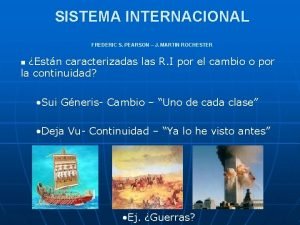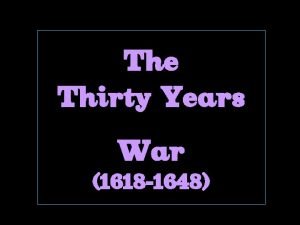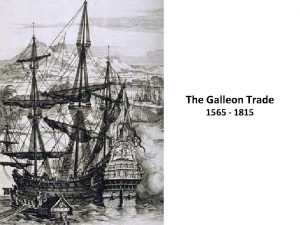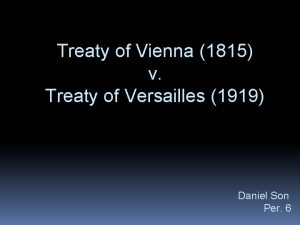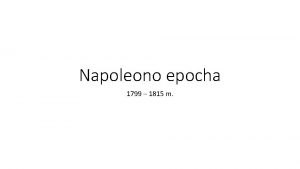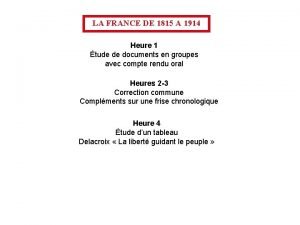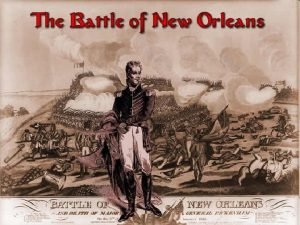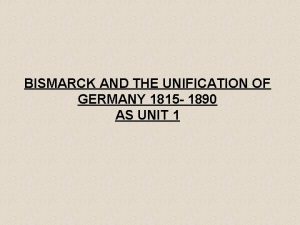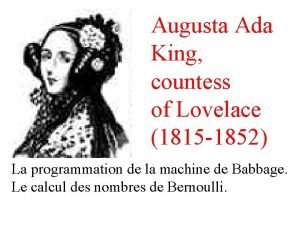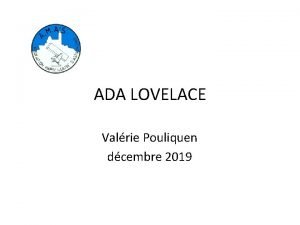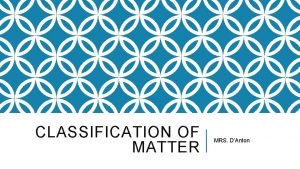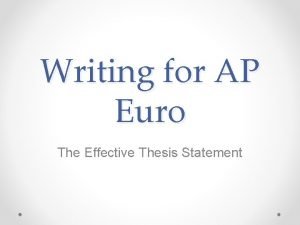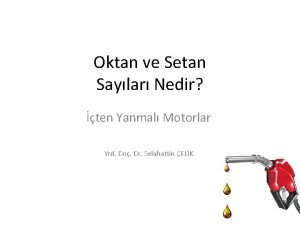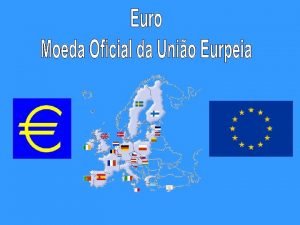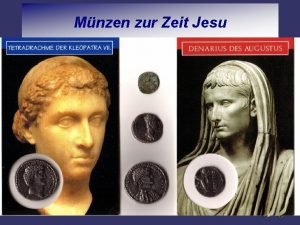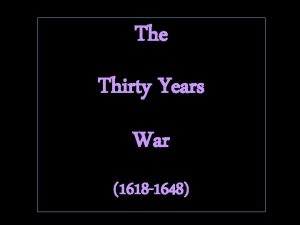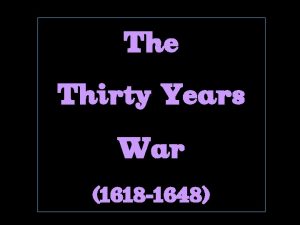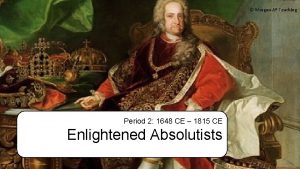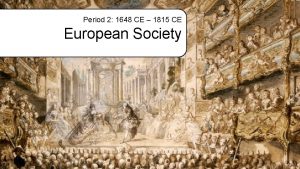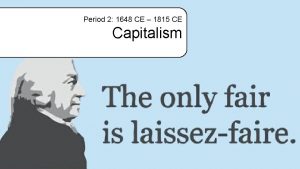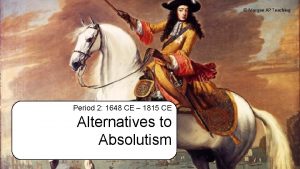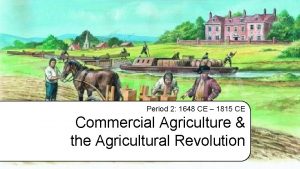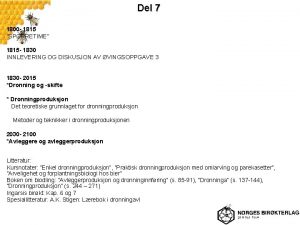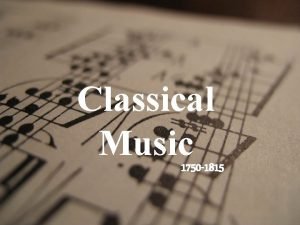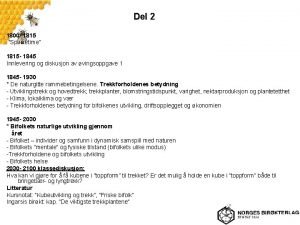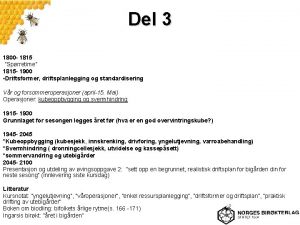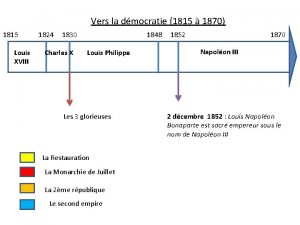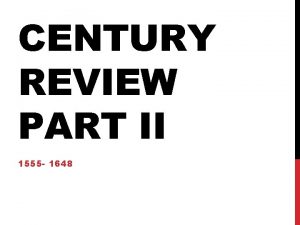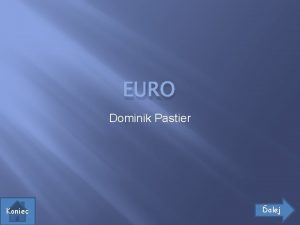AP Euro Review 1648 1815 Part II ProtoIndustrialization









































- Slides: 41

AP Euro Review 1648 -1815 Part II

Proto-Industrialization and the Agricultural Revolution

• • • The Little Ice Age: 14 th – 18 th Centuries Colder winters to Europe and North America Mean average temperatures declined 0. 6 C (1. 1 F) Followed the Medieval Warming Period Cold winters and cool, wet summers led to crop failures and famines Population growth & decline in the death rate with rising temperatures European agricultural system unable to feed its population via feudal common field system


PROTOINDUSTIALIZATION • the period in between feudalism and before the industrial revolution and the major institutions of the factory systems. • Putting-out system/cottage industry – Rural manufacturing – Traditional manufacturing processes – More independence for women – Could not meet demand from rising population (“Proto-industrialization”)

France: SEIGNEURIALISM • Land contract between peasant and lord requiring annual payments and taxes (corvee) to use infrastructure (flour mill, wine press, ovens, etc. ) • Promoted dissatisfaction in late 18 th C. France • prominent in France, Germany, Spain, and Italy. • did not promote technological innovation Le Nain, Peasant Family, 17 th Century.

English Society and Mercantilism • • Post-1689 English promoting distilleries to boost low grain prices and increase trade with its colonies Banned French wine and spirit imports to shift the balance of trade Gin Act of 1736: gin consumption having negative social consequences, government imposed taxes (abolished 1743) ‘the poor only had two enjoyments: sex and drinking’ and “drunkenness was by far the most desired”

William Hogarth (1751) Beer Street Gin Lane

Mercantilism: 17 th-18 th C. • • • The dominant economic and political doctrine among the Western European maritime powers (the Atlantic Five) – Required merchant marine and navy Age of Exploration: Implementation of the Triangular Trade Gold and silver mined and shipped as bullion to Europe where it was minted into coin and circulated in European markets The merchant fleets were privately-owned, joint-stock trading companies sanctioned by the governments – Increased demand for Asian market goods and gun-boat diplomacy – Profit reinvested in overseas ventures AND in agricultural and (later in England) industrial technologies Post-Industrial Revolution, capitalism replaced mercantilism as the dominant economic trend



The Physiocrats: Theory of Wealth, 18 th C. • • • Francois Quesnay – Wealth derived from the value of agriculture – Scientific approach to economics – Unchanging laws governed economic principles – Opposed to government intervention A. R. J. Turgot – Intendant for Louis XV and Comptroller for Louis XVI before French Rev. “no bankruptcy, no taxes increases, no borrowing” Marquis de Condorcet – Equal rights for women, abolition of slavery – Progressive taxation, social welfare

Capitalism: Adam Smith • 1776: The Wealth of Nations • Laissez-faire: Invisible hand – Law of Supply and Demand – Profit-motive – Law of Competition

The Enlightenment – th 18 And Enlightened Absolutism C.

Centers of the Enlightenment

Origins of the Enlightenment • • Scientific Revolution Skepticism Classicism Deism Impact of the Enlightenment on society: ▪ secularism ▪ Revolutions in France and the Americas ▪ laissez-faire capitalism ▪ Education reform ▪ Enlightened despotism in central and eastern Europe

Philosophes ▪ ▪ Philosophes were writers, artists, scientists, musicians, economists, etc. Believed that reason could be applied to all aspects of life Optimistic about how people should live and govern themselves Key concepts: ▪ Secularism ▪ education ▪ Natural Laws ▪ Constitutionalism ▪ Social progress & justice ▪ tolerance ▪ Liberty ▪ Utilitarianism – greatest good for the greatest number • • Voltaire Montesquieu Beccaria Rousseau Diderot Mary Wollstonecraft Mary Astell Emilie du Chatelet

Spread of the Enlightenment Women played a big role in salon movement ▪ Organized by the upper classes, mainly women ▪ Marie-Therese Geoffrin, most influential and patron of Diderot’s Encyclopedia ▪ Madame de Stael later brought German romantic ideas into France in early 1800 s Ideas also spread through coffeehouses, academies, lending libraries and the novel, and Masonic lodges.

Later Enlightenment (18 th C. ): age of skepticism David Hume (1711 -1776) ▪ He claimed desire, not reason, governed human behavior ▪ As a skeptic, he believed human ideas resulted from sensory experiences thus undermining emphasis on reason Immanuel Kant (1724 -1804) ▪ Argued science could describe nature, but could not guide morality ▪ “categorical imperative” was an intuitive instinct, placed by God in the human conscience

Enlightened Despotism (c. 1740 -1815) ▪ Inspired by and encouraged by philosophes ▪ Believed absolute rulers should promote good of the people, but (like Hobbes) people could not rule themselves ▪ Modest reforms: ▪ ▪ Religious toleration Simplified legal codes Access to education Reduction of torture and death penalty

Frederick the Great (II) of Prussia (r. 17401786) War of Austrian Succession (1740 -1748) ▪ Frederick invaded annexed Silesia, part of Austrian Hapsburg empire violating Pragmatic Sanction (1713) ▪ Treaty of Aix-la-Chapelle: Prussia gained Silesia thereby doubling its population ▪ Prussia recognized as one of Europe’s “Great Powers”

Seven Years’ War (1756 -1763) ▪ Maria Theresa sought to regain Silesia with new allies, Russia and France ▪ Diplomatic Revolution 1756: France and Austria ally against Prussia ▪ Britain supported Prussia financially as a check on France ▪ Bloodiest war since Thirty Years’ War ▪ Became world war included struggle for N. America ▪ Prussia on verge of defeat, Peter III pulled Russia out of war in 1763 (assassinated) Treaty of Paris 1763 ▪ Prussia retained Silesia ▪ France lost all its colonies in N. America to Britain ▪ Britain gained more territory in India at French expense

Enlightened Reforms ▪ ▪ ▪ ▪ ▪ “First Servant of the State” Remained an absolute ruler – reforms intended to increase power of state Peasants did not benefit Allowed religious freedom (except Jews) Promoted education Codified laws Freed serfs on crown lands Exams for civil service jobs Reduced censorship Abolished capital punishment Encouraged immigration and industrial and agricultural growth Frederick the Great

Catherine the Great of Russia (r. 1762 -1796) ▪ ▪ ▪ Background: The least “enlightened” of the enlightened despots Educational reforms Restricted torture Limited degree of religious toleration Allowed stronger local governments led by elected councils of nobles Pugachev Rebellion 1773 ▪ ▪ Eugene Pugachev, a Cossack soldier, led huge serf uprising Catherine needed nobles and thus gave them absolute control over serfs

Territorial gains: Shortcomings of reforms: ▪ ▪ Only state and nobility benefitted Serfdom became more severe ▪ ▪ Annexed Polish territory under the 3 partitions with Prussia and Austria in 1772, 1793, and 1795 Gained Ottoman land in the Crimea Conquest of Caucasus region Used lands to curry favor with nobles

Maria Theresa of Austria (r. 17401780) ▪ She centralized control of Hapsburg Empire by limiting power of the nobles ▪ Reduced their power over serfs ▪ Some were freed, feudal dues were reduced or eliminated, nobles were taxed ▪ She did more than any other ruler to improve condition of serfs ▪ Increased army ▪ Improved tax system ▪ Reduced torture ▪ ▪ Brought the Church under state control and taxed it Promoted economy: ▪ Abolished guilds ▪ Encouraged immigration ▪ Improved transportation

Joseph II (r. 1780 -1790) of Austria ▪ Ruled with mother as co-regent until her death ▪ Greatest of enlightened despots in terms of reforms, however, least effective ▪ ▪ ▪ ▪ ▪ Reforms: Abolished serfdom and feudal dues 1781 (rescinded after his death) Freedom of religion and civic rights to Protestants and Jews Reduced influence of Catholic Church Freedom of the press Reformed judicial system (abolished torture and death penalty) Expanded state schools Established hospitals, insane asylums, orphanages, and poorhouses Made parks and gardens available to public Made German official language

Decline of Hapsburg Empire under Joseph II ▪ Austria defeated several times in wars with Ottomans ▪ Austrian Netherlands in revolt ▪ Russia threatening territory in eastern Europe and Balkans ▪ Brother, Leopold II, reversed many reforms to maintain empire

1. 2. 3. 4. 5. Neoclassical Art, 18 th C. renewed interest in classical antiquity. The Neoclassical movement encompassed painting, sculpture, but architecture is regarded as the most prominent manifestation of this interest & fascination with Greek and Roman culture. The geometric harmony of classical art & architecture seemed to embody Enlightenment ideals. Greco-Roman traditions of liberty, civic virtue, morality, and patriotic sacrifice served as ideal models. The Neoclassical style became the French Revolution’s semiofficial voice. Ingres, Apotheosis of Homer, 1827, Louvre, Paris. Boyle & Kent, Chiswick House, London, 1725.

acques-Louis David, Oath of the Horatii, 1784 (salon of 1785) oil on canvas, 3. 3 x 4. 25 m (Louvre) • Transition from the sensual frivolity of the Rococo period to the emphasis on reason and morals of the Neoclassical period • Born out of the Enlightenment Antonio CANOVA (1757 – 1822)Psyche Revived by Cupid’s Kiss. Marble

The French Revolution & Napoleon 1789 -1815

Four Stages of the Revolution 1. Moderate Bourgeois Stage (1789 -1793) 1 st Constitution & Declaration of Rights (National Assembly – Legislative Assembly) • 2. Reign of Terror (1793 -1794) Radical & bloody phase under Maximilien Robespierre • (National Convention) 3. Conservative Phase: Backlash against the Terror (17951799) 1. Attempts at stability & moderation (The Directory) Shifts back toward dictatorship (1799 -1815) • • Napoleon becomes consul (dictator), and later, emperor (French Empire)

Why did millions of French people suddenly revolt againstitutions their ancestors had accepted for hundreds of years? Causes of the French Revolution: 1. Enlightenment philosophy 2. American Revolution 3. Social inequality – the “Ancien” (Old) Regime 4. Economic crisis in France Bourgeois Phase 1789 -1792: • 1789: Louis XVI and the Estates- General • Tennis Court Oath (June) • The National Assembly – Fall of the Bastille (July) – The Great Fear • Declaration of the Rights of Man and Citizen (August) – Olympe de Gouges (1791) • Women’s March on Versailles (October) • 1790: Civil Constitution of the Clergy • 1791: 1 st French Constitution & the Legislative Assembly • Royals flee! • 1792: Brunswick Manifesto and the First Coalition • September Massacres

Radical Phase (1793 -1794) • • 1792: the National Convention (Sept. ) under Girondin rule 1793: execution of the king (Jan. ) Committee of Public Safety (June) – Robespierre, Danton, Marat – Levee en Masse (August) Death of Marat (July) – Charlotte Corday Robespierre’s Republic of Virtue and the Reign of Terror under Jacobin rule – De-Christianization – New Calendar Marie Antoinette executed (Oct. ) Demachy, Pierre-Antoine: Une 1794: Thermidorian Reaction (July) Exécution capitale, place de la Révolution, 1793

Conservative Phase, 1795 -1799 • 1795: The Directory – Corrupt – Unstable – Challenges from left and right – Gives Napoleon command of French Army • Victories abroad – returns a hero • 1799: Brumaire Coup Bouchot, The Brumaire Coup d’Etat, 1799, 1837, Versailles.

Age of Napoleon, 1799 -1815 Policies • • 1801: Concordat 1803: Louisiana Purchase 1804: Emperor Napoleon I Napoleonic Code Military Conquests & Defeats • • Haitian revolt and independence by 1804 Multinational coalitions against Napoleon – The British and Horatio Nelson • Trafalgar, 1805 – Continental System, 1806 – Peninsular War, 1808 -1813 • Horrors of War, Goya – Invasion of Russia, 1812 – Battle of Leipzig, 1813 – Elba and escape: the Hundred Days, 1815 – Waterloo

The Spanish Ulcer

The Continental System Russian Invasion

Metternich Restores Stability A. Congress of Vienna, 1814 -15 1. The 5 “Great Powers” met to set up policies to achieve a lasting peace in post -Napoleonic Europe 2. Prince Klemens von Metternich of Austria was the most influential & was very distrustful of democratic ideals of the French Rev. King Frederick William III of Prussia Emperor Francis I of Austria Wellesley, Duke of Wellington, Britain Talleyrand of France Czar Alexander I of Russia Prince Klemens von Metternich of Austria

The Congress of Vienna, 1814 -1815 1. 2. Restore a Balance of Power: no country would be a threat to others • Forced to give up territories Napoleon took, but kept 1790 boundaries & overseas possessions, army & gov • Containment of France: prevent future aggression by surrounding France w/ strong countries Legitimacy: Restore Europe’s families to thrones that had been driven out by Napoleon • France: Louis XVIII ruled as a Constitutional Monarch • Spain, Italy, Germany: rulers restored 3. Concert of Europe – Principle of Intervention

Europe 1815
 Branches of catholic church
Branches of catholic church Sistema clasico internacional 1648 a 1789
Sistema clasico internacional 1648 a 1789 Bohemian phase
Bohemian phase Chapter review motion part a vocabulary review answer key
Chapter review motion part a vocabulary review answer key Ottoman empire in 1750
Ottoman empire in 1750 Junk ship
Junk ship Scopul sfintei aliante
Scopul sfintei aliante Treaty of vienna 1815
Treaty of vienna 1815 Banginio ir liuto kova
Banginio ir liuto kova Frise chronologique 1815 à 1870
Frise chronologique 1815 à 1870 Frise chronologique de 1815 à 1870
Frise chronologique de 1815 à 1870 Fired our guns and the british kept coming
Fired our guns and the british kept coming 1815
1815 Liberalism and nationalism in germany 1815-71
Liberalism and nationalism in germany 1815-71 Lovelace 1815
Lovelace 1815 Ada lovelace family background
Ada lovelace family background Sdružení pro vydávání a šíření českých knih
Sdružení pro vydávání a šíření českých knih Part whole model subtraction
Part whole model subtraction Part to part ratio definition
Part to part ratio definition Part part whole
Part part whole What is technical description
What is technical description Footed ware glassware
Footed ware glassware The part of a shadow surrounding the darkest part
The part of a shadow surrounding the darkest part Part to part variation
Part to part variation Civics 360.org
Civics 360.org Matterlab
Matterlab Ap gov final review
Ap gov final review Nader amin-salehi
Nader amin-salehi Search strategy example
Search strategy example Narrative review vs systematic review
Narrative review vs systematic review Politique definition ap euro
Politique definition ap euro Euro psy
Euro psy Euro isdn
Euro isdn Schlieffen plan ap euro
Schlieffen plan ap euro Romanticism
Romanticism Stepper faydaları
Stepper faydaları Moedas de euro dos varios países faces nacionais
Moedas de euro dos varios países faces nacionais 1 denar zur zeit jesu in euro
1 denar zur zeit jesu in euro Eurohouse music
Eurohouse music Docomo euro labs
Docomo euro labs Euro btp futures
Euro btp futures Euro global map
Euro global map

